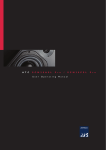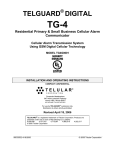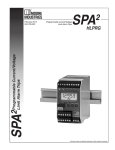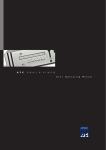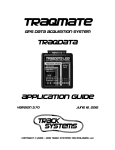Download Manual - AllegroSound
Transcript
Amplifiers User Manual: CA2 Preamplifier SCA2 Preamplifier SIA2-150 Integrated Amplifier SPA2-150 Power Amplifier SPA2-200P Power Amplifier M U LT I C H A N N E L ® AC O U S T I C ENGINEERS Electronics Introduction Welcome. In selecting ATC you have chosen an example of the finest audio engineering available. ATC was founded on a principle of engineering excellence, and that principle still defines our products today. Given the right opportunities, ATC products will deliver exceptional audio performance, but the opportunities will only arise from careful and thoughtful installation and use. Please read the following manual fully. It will help you understand the product and to realise its full potential.We are happy to answer questions and offer advice on any issues that arise through installation or use of ATC products. Contact details can be found at the back of this manual. ATC was founded in London in 1974 by Australian emigre Bill Woodman, who still Contents heads the company today. An enthusiastic pianist and engineer he was naturally drawn to loudspeaker design and after a period working at Goodmans, where many Page 2 Page 3 of the names that went on to found British loudspeaker companies began their CA2 Preamplifier Section 1.1 Description Section 1.2 Installation Section 1.3 Mains Connection careers, he struck out on his own.The premise on which ATC began is a simple one, Page 4 Section 1.4 Inputs speakers tend to express the opposite character. ATC products were designed from Page 5 Section 1.5 Section 1.6 Outputs Operation the outset to offer the best of both. It’s an easy concept to describe, but surprisingly Page 6 Section 1.7 Section 1.8 Section 1.9 Remote Handset Care and Maintenance Warranty and Contact Specifications Page 7 and one that in many respects is still true today: hi-fi loudspeakers tend to be detailed and accurate but of limited dynamic range, while professional monitor difficult to engineer. The difficulty inherent in designing such loudspeakers is one of scale. Hi-fi levels of accuracy and detail call for lightweight moving parts and delicate engineering. SCA2 Preamplifier Section 2.1 Description Section 2.2 Installation Section 2.3 Mains Connection Professional monitor levels of performance however demand far more robust Page 8 Section 2.4 Inputs and scale more often associated with aerospace or motorsport. But the results are Page 9 Section 2.5 Section 2.6 Outputs Operation worth the effort and the cost. ATC loudspeakers, with their unique in-house Page 10 Section 2.7 Remote Handset Page 11 Section 2.8 Section 2.9 Care and Maintenance Warranty and Contact Specifications Page 12 SIA2-150 Integrated Amplifier Section 3.1 Description Section 3.2 Installation Section 3.3 Mains Connection Section 3.4 Inputs Page 13 Section 3.5 Section 3.6 Section 3.7 Outputs Operation Remote Handset Page 14 Section 3.8 Section 3.9 Care and Maintenance Warranty and Contact Specifications Page 15 2 Introduction SPA2-150 & SPA2-200P Power Amplifiers Section 4.1 Description Section 4.2 Installation Section 4.3 Mains Connection Section 4.4 Inputs components engineered to survive the rigours of high level use for extended periods.The only way to combine the two is through precision engineering of a class designed drivers, combine the best of hi-fi and professional to devastating effect. ATC has become synonymous with active systems. Choosing to offer active loudspeakers (where the passive crossover network is replaced by active filters and multiple power amplifiers) is simply a result of the uncompromising attitude to loudspeaker design.While passive systems still have their place, and ATC engineering skills can still bring remarkable results from them,“active” is a fundamentally better solution to the problems posed by accurate, high level music reproduction.The ATC instinct is always for the better solution. Not cheaper, not quicker, but better. It was the development of active loudspeakers that first brought ATC into electronics design and engineering. Active speakers demand multiple power amplifiers so ATC from the mid 1980s became not just a loudspeaker manufacturing company but an electronics manufacturer too.The further step from electronics for active speakers to a range of stand-alone amplifier products was natural and now means that ATC engineering is available from the recording desk or CD player output to the ears. Page 16 Section 4.5 Section 4.6 Section 4.7 Signal Cable Options Outputs Operation From modest beginnings ATC has grown to become one of the very few Page 17 Section 4.8 Remote Operation ATC you join a group of music lovers, professional audio engineers, studios and Page 18 Section 4.9 Section 4.10 Care and Maintenance Warranty and Contact Specifications musicians across the World that understand and value the engineering that goes into manufacturers successful across both domestic and professional audio. By selecting an ATC product - and the sound that comes out. Power Amplifiers 4.1 Description SPA2-150/200P The mains cable is specifically supplied to comply with local statutory safety approvals and The SPA2-150 and SPA2-200P are high quality power amplifiers designed to partner alternatives should not be substituted. If you ATC passive monitors and other loudspeaker systems. They are both capable of intend to use your power amplifier in an output power considerably in excess of specification. Both also incorporate the same alternative territory please contact ATC for gain reduction and loudspeaker protection circuits as ATC’s active monitors. This advice. The mains connection must always be ensures that even when working at very high levels the amplifiers are held back from earthed. clipping so improving the subjective performance and protecting the loudspeakers from damage. A power supply fuse is fitted to the rear panels of the power amplifiers. The fuse is 20mm “Type T The SPA2-200P features a stereo pair of balanced inputs on XLR sockets while the anti-surge”. Should a unit fail to switch on when SPA2-150 incorporates switch selectable balanced and unbalanced signal inputs on the power switch is operated the fuse should be XLR and RCA phono sockets respectively. Loudspeaker output connections on both inspected. Lift out the fuse holder cover using a power amplifiers are made through two pairs of WBT connectors. small flat-blade screwdriver, remove the fuse and The SPA2-200P includes a multi-pin connector on the rear panel that provides wired inspect it for damage. The fuse rating is 3.15A for remote control interface facilities while the SPA2-150 can be switched into and out of 200V - 250V mains voltage and 6.3A for 100V - Standby mode by either ATC remote handset. 120V. Fuses most often fail only because of a serious electrical fault. If this is the case then Both power amplifiers incorporate comprehensive performance monitoring and feedback through a front panel display. simply replacing the fuse will only result in another fuse failure. The power amplifier should be returned to ATC for service if a second fuse fails. 4.2 Installation The SPA2-200P and SPA2-150 are designed to be free standing. The power dissipation of the amplifiers is considerable and makes them warm to touch. Temperature stability will be reached after approximately three hours from mains switch-on but full audio performance is available immediately and is not influenced by temperatures within the amplifiers’ normal operating range. Care must be taken 4.4 Inputs The SPA2-150 is fitted with both unbalanced RCA Phono and balanced XLR inputs. A switch on the rear panel selects between the two. The SPA2200P incorporates only balanced XLR inputs. not to obscure the ventilation holes in the top and bottom covers. Please contact ATC for advice if the amplifier is required to be mounted in an enclosed area. Note: Do not attempt to connect both balanced and unbalanced inputs at the same time. The The SPA2-150 is an aesthetic match for the SCA2 preamplifier and it is quite in order to sit the SCA2 on top of the SPA2-150.A general recommendation regarding the layout of the system is that the distance between the power amplifier and loudspeakers should be minimised. Reducing the length of speaker cables improves selector switch is not a toggle between the two inputs. The XLR and RCA input connectors are wired in parallel and the switch merely arranges for either balanced or unbalanced input. the control of amplifier over the loudspeaker system through the reduced resistance of the loudspeaker leads. It may therefore be appropriate to locate the The signal is present on the centre conductor of power amplifiers close to the loudspeakers. an unbalanced RCA Phono style input and the signal return is made via the screened outer. If There is no general benefit from reducing the length of the interconnect from the an ATC preamplifier to the power amplifier, especially when balanced connections are used. However, non ATC preamplifiers may not be capable of driving cables of more than a few metres. there is any hum present on the inputs this must be traced to its source and not suppressed by the removal of screens or earths. Removal of the screen on an unbalanced input is likely to result in uncontrollably loud hum. 4.3 Mains Connection The SPA2-150 and SPA2-200P can be used with mains voltages from 100V to 240V, 50/60Hz. Mains voltage is factory set and should only be adjusted by ATC or your local dealer or distributor. It is wise to ensure that the local mains voltage matches that specified on the rear panel before applying mains power. All signal cables and plugs should be of a good quality. Poor cable and plug quality will compromise the performance of your system.The signal input pin configuration for XLR sockets is illustrated in Diagram 1 while Diagram 2 illustrates a balanced cable. 15 SPA2-150/200P Power Amplifiers I n s t a l l a t i o n c o n t ’d 4.5 Signal Cable Options Diagram 1 - input connection pins Balanced cables are always the preferred option, for the SPA2-150P however unbalanced connection is possible. Diagrams 2 and 3 illustrate the signal cable connections required for each option. Balanced (XLR to XLR) connection offers Pin 2, Signal (hot) Pin 1, Screen Pin 3, Signal (return) lower noise and better immunity to “hum” pickup. Unbalanced (XLR to Phono or Two Pole Jack) connection carries risk of hum caused by multiple signal earths. Hum problems resulting from unbalanced connection may be reduced by making ONE of the Diagram 2 - balanced cable following modifications to the signal cable connections: If the driving preamplifier (or desk) is 3 Pin Male XLR Connector “double insulated” (i.e. has no mains earth), disconnect the signal cable screen at the RCA Phono plug end. Alternatively, disconnect the signal 3 Pin Female XLR Connector Two Core Screened Cable 2 Hot Return 2 1 Screen 1 3 cable screen at the XLR end.This second option will make the source the reference signal earth. 4.6 Outputs To Power Amplifier Input 3 To Source Output Diagram 3 - unbalanced cable Loudspeaker connections are made to the SPA2150 and SPA2-200P through WBT connectors on the rear panels. The left and right channels are 3 Pin Male XLR Connector clearly marked. The loudspeaker terminals are labelled positive and negative. The wire used for the connections to the monitors will have some identification for the positive conductor. Usually this is red, but may be a moulded stripe on the Phono (RCA) Connector Two Core Screened Cable 2 Hot Return 1 Screen 3 To Power Amplifier Input To Source Output insulation. The terminals will accept either bare wire up to 5.7mm diameter or 4mm male plugs. When bare wire connections are made the insulation should be carefully removed to expose 12mm of conductor. The conductors should be tightly twisted together and inserted into the connector ensuring that no stray strands of wire cause a short circuit. It is important that both loudspeakers are connected with the same polarity. That is; both positive loudspeaker terminals are connected back to positive amplifier terminals and both negative loudspeaker terminals connected back to negative amplifier terminals. The SPA2-150 and SPA2-200P are suitable for loudspeaker systems with a nominal impedance of 4 Ohms or greater. 16 4.7 Operation Once connected to mains power and powered-up from the rear panel mains switch, the front panel Standby button (or ATC remote handset Standby button) will switch the SPA2-150 between standby and active modes. The SPA2-200P can only be operated remotely by a custom wired remote system With the power switch on, the front panel Standby indicator will illuminate. The unit will then respond to control either from the front panel or, in the case of the SPA2-150 an ATC remote handset.The Standby button on the front panel will switch the amplifier between active and standby modes. The rear panel power switch should be used to isolate the SPA2-150 and SPA2-200P from the mains supply if the units are to be unused for any significant period. When switched into active mode the unit will go into an initialisation sequence under the control of the internal microprocessor.The standby indicator will extinguish and be replaced by the LED display displaying 0 followed by a flashing decimal point. At this time it is quite possible that the loudspeakers will emit a mild thump as the SPA2-150/200P O p e r a t i o n c o n t ’d amplifier powers up and the initialisation routine is Diagram 4 - Display legends carried out. When, after a few seconds, the initialisation is complete, the figure 0 is replaced by a constantly lit decimal point.The unit is now in the Initialisation:The decimal point flashes to show initialisation is in progress. normal active mode. The initialisation sequence is illustrated in Diagram 4. An indicator adjacent to the left of the Standby Normal Operation:The decimal point illuminates to show the amplifier is powered-up and is healthy. button illuminates when the amplifier receives remote control signals. It will also illuminate if the signals received are not intended for the amplifier CD or preamplifier controls for example. At all times during the operation of the SPA2-150 and SPA2-200P their internal microcomputer will monitor the important aspects of amplifier Over Temperature: Indicates that the temperature is over 90ºC in the left amplifier channel.This condition will shut down the amplifier. Pressing the Standby button will restore the amplifier to normal only if the temperature has dropped significantly. Over Temperature: Indicates that the temperature is over 90ºC in the right amplifier channel.This condition will shut down the amplifier. Pressing the Standby button will restore the amplifier to normal only if the temperature has dropped significantly. operation.Their front panel LED displays will warn of overdrive and fault conditions on either or both channels. The units will shut down if excessive temperature or DC offset faults arise but, as the amplifiers are designed to accommodate overdriving abuse indefinitely, they will keep running. Sound quality will however be impaired by Over Temperature: Indicates that the temperature is over 90ºC in both amplifier channels.This condition will shut down the amplifier. Pressing the Standby button will restore the amplifier to normal only if the temperature has dropped significantly. DC Offset: Indicates a DC voltage of greater than 1V present on the output of the left amplifier.This condition will shut down the amplifier. Pressing the Standby button will restore the amplifier to normal only if the fault has been cleared. the operation of the protection circuitry. There is also the possibility of damage to the loudspeakers when driven at such high levels. It is therefore prudent to reduce the system volume level to below the overdrive indication threshold. The display and its interpretation is illustrated in Diagram 4. DC Offset: Indicates a DC voltage of greater than 1V present on the output of the right amplifier.This condition will shut down the amplifier. Pressing the Standby button will restore the amplifier to normal only if the fault has been cleared. DC Offset: Indicates a DC voltage of greater than 1V present on the output of both amplifiers.This condition will shut down the amplifier. Pressing the Standby button will restore the amplifier to normal only if the fault has been cleared. Excessive temperature and DC offset are both potentially very damaging and the amplifier will shutdown whilst displaying the fault condition that Overdrive: Indicates that maximum drive has been reached on the left amplifier and that the gain reduction circuits are operating to prevent clipping. caused the problem. Excessive temperature is only likely if the output load is too great or if the ventilation is inadequate.The amplifier will not reset until the operating temperature has had time to Overdrive: Indicates that maximum drive has been reached on the right amplifier and that the gain reduction circuits are operating to prevent clipping. return to normal. DC offsets generally indicate a faulty source or preamplifier. The power amplifier will not reset until the fault has been cleared. Overdrive: Indicates that maximum drive has been reached on both amplifiers and that the gain reduction circuits are operating to prevent clipping. Due to the nature of the electronics in ATC amplifiers it is quite normal for a sound to be heard from the speaker when the power is applied or disconnected.The noise heard will not damage 4.8 Remote Operation the speaker and is quite normal. Although ATC uses the highest-grade components, a different ATC remote control handsets may be used with the SPA2-150 to provide remote noise may be heard from each speaker due to operation of the standby function. slight tolarance variations in the amplifier components. The SPA2-200P incorporates a rear panel multipin connector that enables custom remote control systems to be developed. Please contact ATC directly for technical information and advice on the development of such systems. 17 SPA2-150/200P Specifications SPA2-150 4.9 Care and Maintenance SPA2-200P Output Power 150 Watts/Channel into 8 Ohms 200 Watts/Channel into 8 Ohms Balanced Input Sensitivity 1V 1V Balanced Input Impedance 10 kilohms 10 kilohms Balanced Input C.M.R.R -90dB @ 1kHz -90dB @ 1kHz Unbalanced Input Sensitivity 2V 2V Unbalanced Input Impedance 10 kilohms 10 kilohms Signal/Noise >110dB >110dB Amplitude Response 5Hz - 200kHz ±0.1dB 5Hz - 200kHz ±0.1dB Crosstalk <-105dB <-105dB Distortion (at rated power) <-95dB <-95dB Power Requirements: 100, 115, 230V factory set, 50/60Hz Power Consumption 10 VA (Standby minimum) 180 VA (Nominal) 600 VA (Rated Output) Dimensions (HxWxD) 146 x 440 x 426mm 130 x 428 x 325 Overall Weight 26kg (57.3lb) 22kg (48.5lb) 100, 115, 230V factory set, 50/60Hz 10 VA (Standby minimum) 180 VA (Nominal) 600 VA (Rated Output) ATC reserves the right to vary products and specifications without prior notice. Acoustic Transducer Co. is a trading name and ATC is the registered trade mark of Loudspeaker Technology Ltd. High technology metal finishes are used in these products.The surfaces are durable and with a little care can be kept as good as new even under conditions of heavy use. Normally a dry duster will be all that is required to keep the finishes clean. Heavier soiling of the aluminium can be cleaned using a cloth slightly moistened with a nonabrasive household cleaner - taking extreme care not to allow any liquid to enter the units. Switch off and disconnect the units from the mains power before cleaning. There are no components within the units that would benefit from regular maintenance. There is no requirement for any kind of routine service 4 . 1 0 Wa r r a n t y a n d C o n t a c t work and there is no schedule for preventative maintenance. There are no user replaceable parts within the units and in the unfortunate event of any malfunction, repair should be referred to either All ATC products are guaranteed against any defect in materials or workmanship for a period of two years from the date of purchase.Within this period we will supply replacement parts free of charge provided that the failure was not caused by misuse, accident or negligence. the supplying dealer or consultant, the relevant Purchasers who complete and return the Warranty Card will have their distributor, or ATC. warranty period extended up to a period of six years from the date of purchase.This guarantee does not limit statutory rights. ATC can be contacted at: Loudspeaker Technology Ltd, Gypsy Lane, Aston Down, Stroud, Gloucestershire GL6 8HR, UK. 18 Telephone: 01285 760561 Fax: 01285 760683 Email: [email protected] Website: www.atc.gb.net ® AC O U S T I C ENGINEERS Loudspeaker Technology Ltd, Gypsy Lane, Aston Down, Stroud, Gloucestershire GL6 8HR United Kingdom Telephone 01285 760561 Fax 01285 760683 Email: [email protected] Website: www.atc.gb.net










